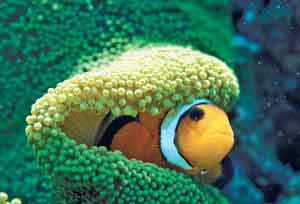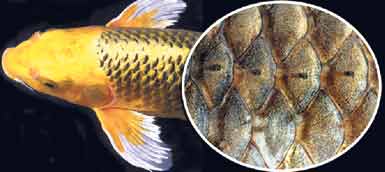What is a coral reef?
Real coral reefs are veritable cities in the sea that are inhabited by many creatures including mysterious starfish, curious tangs, and captivating clown fish. At least 2,000 species of fish, 5,000 species of molluscs, and 700 species of coral live there. Also, an uncountable amount of crabs, urchins, worms and sea cucumbers have found their home in the ancient coral reefs. In other words, 25 percent of all known marine fishes live in coral reefs. At the same time coral reefs only occupy half a percent of the marine environment!
 |
| One of the great adventures of co-habitation on the coral reef. The clown fish (Amphiprion ocellaris) hides in the arms of the carpet anemone where it remains safe from predators and in return acts as a warning to the anemone of would be predators through its behavior. |
Coral reefs are made of limestone formations that are actually the skeletons of tiny sea corals. They first appeared 700 million years ago in the clear, shallow and warm seas of the world and over many years, they grew into exotic habitats. They are found in the waters of about 100 countries, mostly in the Caribbean, the Central Pacific and off East Africa into the Red Sea.
Meet the real inhabitants of coral reefs
Reefs offer a cast of amazing creatures.The clown fish and the anemone live one of nature's great partnerships.
The clownfish is the only species known to be immune to the anemone's venom. It lives within the protective tentacles of the anemone, giving it the nickname the "anemone fish."
Clown fish can be found on the sea floor inhabiting the warm waters of the tropical Pacific Ocean, the Red Sea, the Indian Ocean and Australia's Great Barrier Reef. There are at least 27 known species of clown fish.
The fins of tropical fish swimming through the corals show all sorts of bright hues and exotic patterns. The longnose butterfly fish (Forcipiger longirostris) makes extra use of such colour. It has a false eye on its tail to fool predators that think they are really attacking its head. With this trick, the longnose butterfly fish can swish its fins and dart off the other way.
The blue tang (Paracanthurus hepatus) lives throughout the Indian Ocean and West Pacific, and is found on nearly the entire length of the Great Barrier Reef. They have blades on their tails and venomous fin spines, though when they are alarmed they usually just hide in small groups in the branches of corals.
Yellow tangs, or
surgeonfish, live in schools in coral-rich areas of lagoon and seaward reefs in the Pacific Ocean. They have a white spot near the base of their tail that is actually a sharp, retractable spine used in defence and
combat.
 |
| Various soft corals.
Soft corals are colonial animals made up of thousands of polyps. These are formed by new individuals budding off from the original one.
They grow about two centimetres each year. |
Starfish delight beach goers around the world and continue to amaze scientists with their mysterious evolution. In the African country of Benin, legend calls them the children of the moon. Living in all of the seas of the world at all depths, they have been with us for 500 million years.
Starfish have dozens of tiny feet that enable them to slowly move from place to place. Each step is a complicated gesture as it hauls itself forward, like front wheel drive, then adheres to a surface, and then flexes before removing itself from the surface. Large starfish tend to move at dusk while the small ones wait for night to fall.
A history of coral on land
In some parts of the world, coral reefs have played an important spiritual role for nearby humans.
In Samoa, the flooring of a chief's house is made of crushed coral and covered by small stones or matting.
In the Society Islands of Oceania, initiation rites include walking over fired coral skeletons.
The Romans wore red coral, which is uniquely found in the dark depths of water, as an amulet and adorned infants with a coral necklace to protect them from contagious diseases.
More recently, doctors have also successfully used coral as a way to heal or replace fractured bones.
Coral reefs in danger
Reefs face ever more threats from humans. Some people use dynamite to obtain coral for jewellery and capture tropical fish in the coral reefs for aquariums. Pollution from factories and increased seaside building also adds to the problem.
Scales for Safety
When you go swimming in the river, you are told to be careful about the rocks, as you may bruise yourself if you hit against them. But, fish swim in the water all the time. Through cracks and crevices in rocks inside the water, and between the branches of thorny water plants.
They do not get bruised so easily. And its not because their parents had given them sound advice. They don't have to. They know the little fish are safe.
Fish have tough scales on their bodies which serve as a protective layer and guard them against predators and a harsh environment.
The toughness of the scales depends on the lifestyle of the fish and its home. That is why the scales of fishes who live near the coast or in reefs are always stronger than those of fishes living in deeper waters, where they do not encounter too many ragged surfaces.
For instance, the scales of the Coelacanth fish are so rough and tough that people living in the Comoro Islands use it as a substitute for
sandpaper.
Fish scales are also
covered with mucus that makes the skin
slippery and gives extra
protection. The mucus is
produced by special cells under the scales.
|



